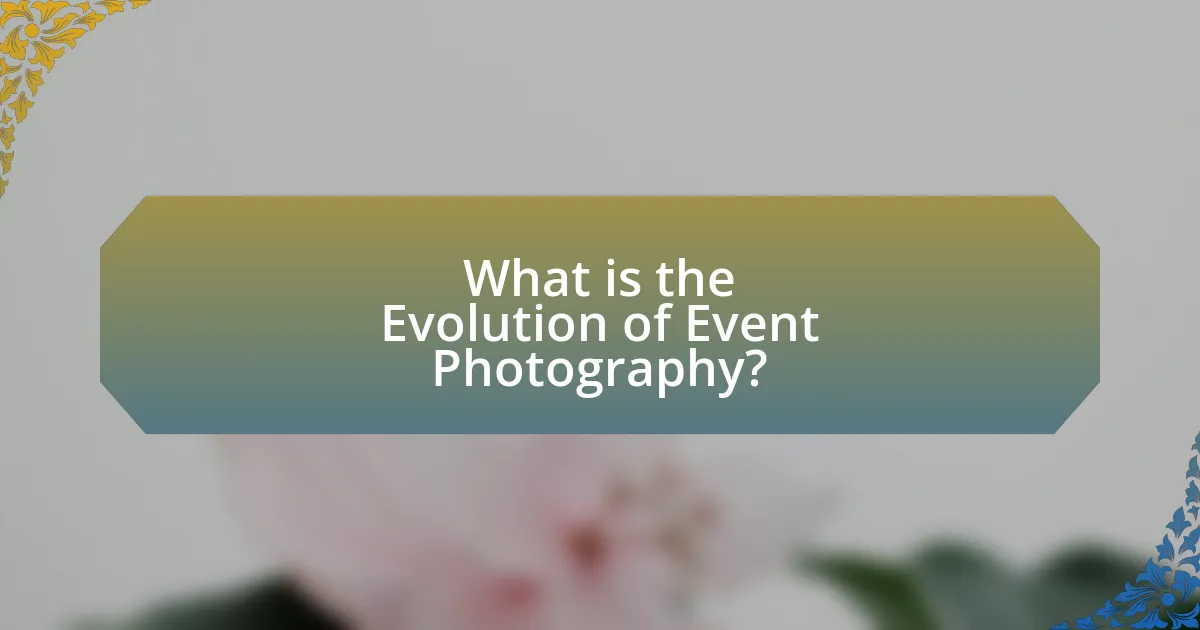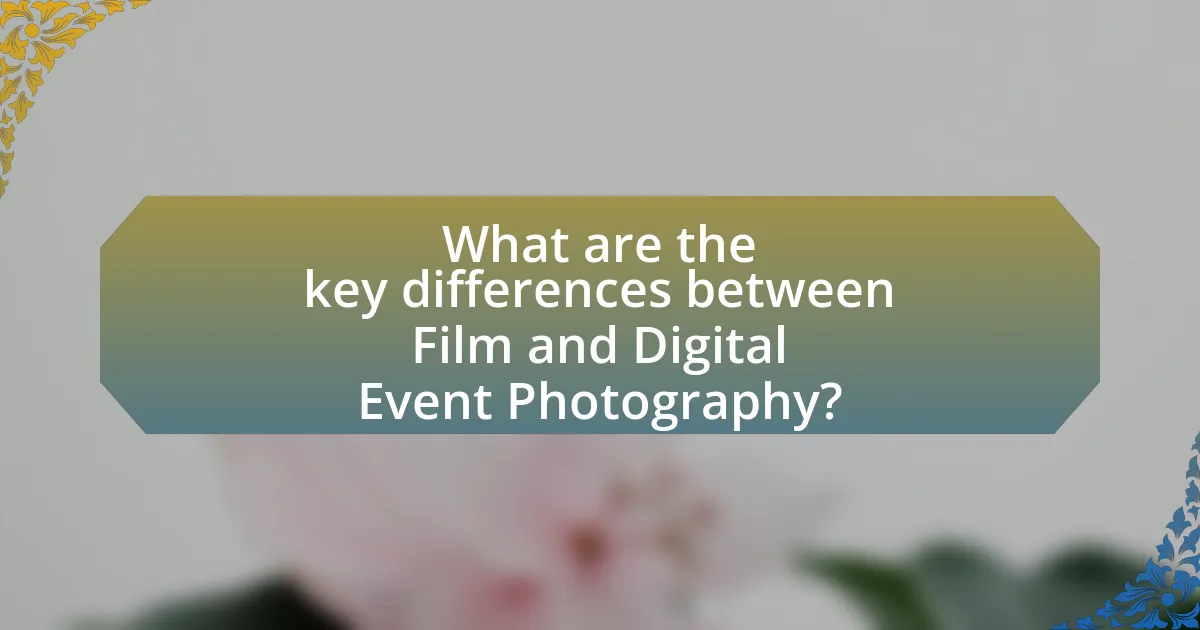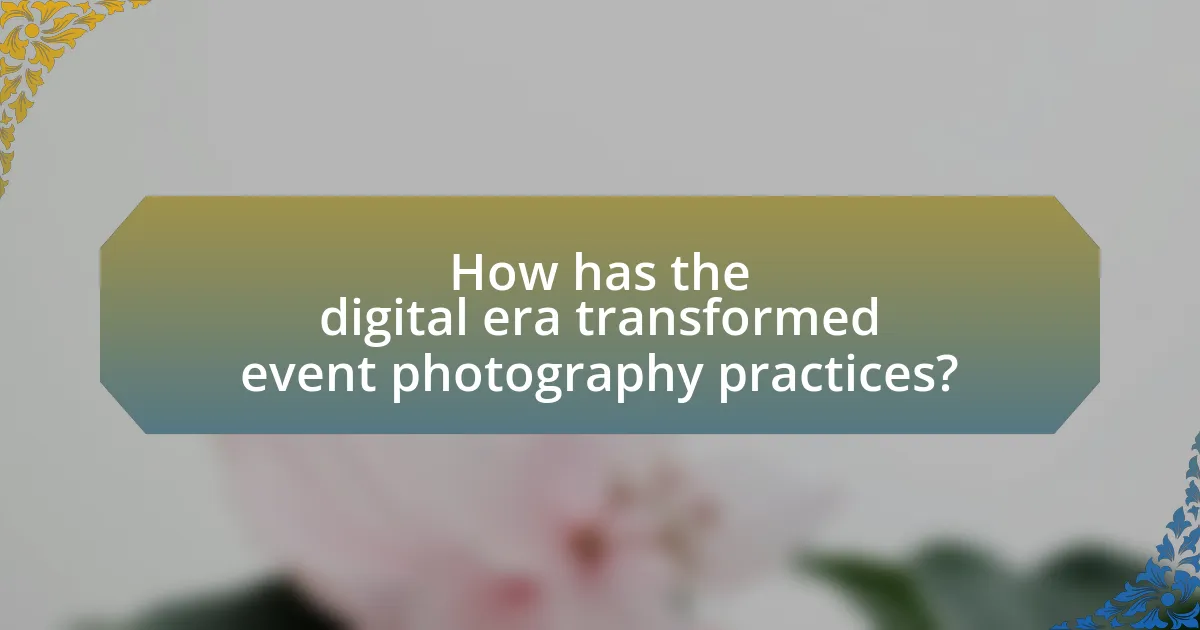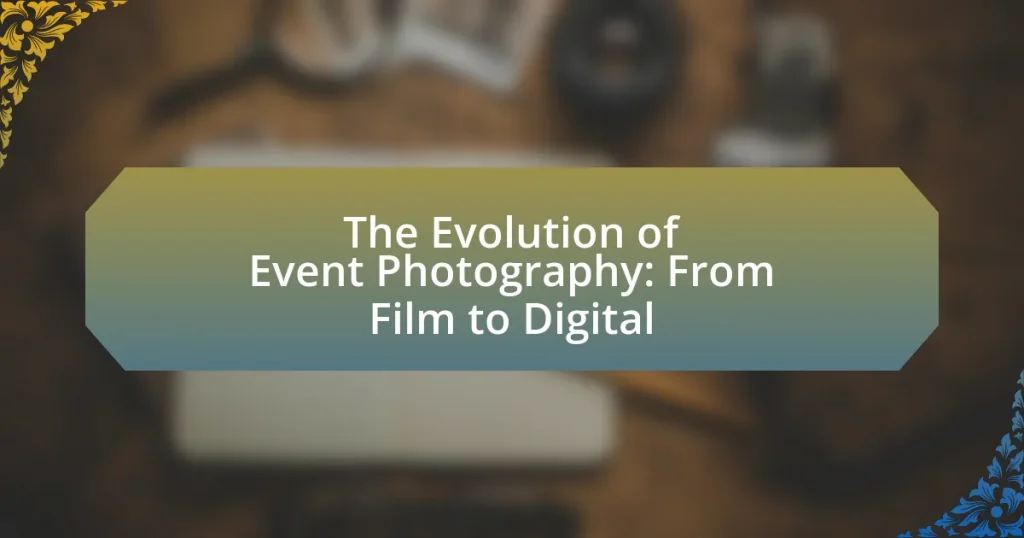The article examines the evolution of event photography, highlighting the transition from film-based techniques to digital technology. It discusses key milestones in this transformation, including the introduction of digital cameras and the impact of social media on how event images are shared and consumed. The article also explores the advantages of digital photography over film, such as instant image review and enhanced editing capabilities, as well as current trends like candid photography and drone usage. Additionally, it addresses best practices for photographers in the digital age, emphasizing the importance of effective marketing and quality enhancement techniques.

What is the Evolution of Event Photography?
The evolution of event photography has transitioned from film-based techniques to digital technology, significantly enhancing accessibility and quality. Initially, event photography relied on film cameras, which required careful planning and limited the number of shots due to the cost of film and development. The introduction of digital cameras in the late 1990s revolutionized this field, allowing photographers to capture images instantly, review them on-site, and take numerous shots without the constraints of film.
Digital photography also enabled the rise of editing software, which further improved the quality of images and allowed for creative enhancements. According to a report by the International Photography Industry Association, the digital photography market grew exponentially, with digital camera sales surpassing film camera sales by 2004. This shift not only democratized photography, making it more accessible to amateurs and professionals alike, but also changed the way events are documented, with real-time sharing on social media platforms becoming a standard practice.
How has event photography changed over the decades?
Event photography has transformed significantly over the decades, primarily shifting from film to digital technology. In the 1980s and 1990s, photographers relied on film cameras, which required careful planning and limited shots due to the cost of film and development. The introduction of digital cameras in the early 2000s revolutionized this practice, allowing for immediate image review, unlimited shooting, and easier editing.
Additionally, the rise of social media platforms has changed how event photography is shared and consumed, with instant uploads and real-time engagement becoming the norm. This evolution has also led to a greater emphasis on candid moments and storytelling, as photographers adapt to the fast-paced nature of digital sharing. The shift from traditional methods to digital formats has made event photography more accessible and versatile, catering to a wider audience and diverse event types.
What were the key milestones in the transition from film to digital?
The key milestones in the transition from film to digital photography include the introduction of the first digital cameras in the late 1970s, the launch of the first commercially successful digital camera, the Kodak DCS 100, in 1991, and the widespread adoption of digital cameras in the early 2000s. The late 1970s marked the beginning with the development of the first digital sensors, which allowed images to be captured electronically. The Kodak DCS 100, which utilized a 1.3-megapixel sensor, represented a significant advancement, enabling professional photographers to capture images digitally for the first time. By the early 2000s, digital cameras became more affordable and accessible, leading to a rapid decline in film usage and a shift in the photography industry towards digital formats.
How did technological advancements influence event photography?
Technological advancements significantly influenced event photography by transitioning from film to digital formats, enhancing image quality and accessibility. The introduction of digital cameras in the late 1990s allowed photographers to capture high-resolution images instantly, eliminating the need for film development and enabling immediate feedback. This shift increased the volume of photographs taken at events, as photographers could shoot continuously without the constraints of film rolls. Additionally, advancements in editing software, such as Adobe Photoshop, provided tools for post-processing that improved the final output, allowing for greater creativity and precision in image enhancement. The rise of smartphones equipped with high-quality cameras further democratized event photography, enabling anyone to capture and share moments instantly, thus expanding the reach and impact of event documentation.
Why is understanding the evolution of event photography important?
Understanding the evolution of event photography is important because it highlights the technological advancements and shifts in artistic approaches that have shaped the field. The transition from film to digital photography has revolutionized how events are captured, allowing for greater accessibility, immediacy, and creativity. For instance, the introduction of digital cameras in the late 1990s significantly reduced costs and increased the volume of photographs taken at events, as photographers no longer had to worry about film development expenses. This evolution has also led to the rise of social media, where instant sharing of event images has transformed audience engagement and expectations. Thus, recognizing these changes is crucial for photographers to adapt their skills and techniques to meet contemporary demands and leverage new opportunities in event photography.
What insights can we gain from the history of event photography?
The history of event photography reveals the evolution of technology and societal changes in capturing significant moments. Initially, event photography relied on film, which required careful planning and limited spontaneity due to the constraints of exposure times and film development. The transition to digital photography in the late 20th century revolutionized this field, allowing for immediate image capture and editing, thus enhancing the ability to document events in real-time. This shift not only increased accessibility for amateur photographers but also transformed professional practices, as seen in the rise of social media platforms that prioritize instant sharing of event images. The historical progression from film to digital highlights the growing importance of visual storytelling in contemporary culture, emphasizing the role of photography in shaping public perception and memory of events.
How does the evolution impact current practices in event photography?
The evolution from film to digital technology has significantly transformed current practices in event photography by enhancing accessibility, efficiency, and image quality. Digital cameras allow photographers to capture high-resolution images instantly, facilitating immediate review and adjustments, which was not possible with film. This shift has led to a reduction in costs associated with film development and printing, enabling photographers to offer more competitive pricing and increased service options. Additionally, advancements in editing software and online sharing platforms have streamlined the post-production process, allowing for quicker delivery of images to clients. The integration of social media has also changed how event photography is marketed and consumed, with real-time sharing becoming a standard expectation.

What are the key differences between Film and Digital Event Photography?
The key differences between film and digital event photography lie in the medium of capture, processing time, and image manipulation capabilities. Film photography uses chemical processes to capture images on light-sensitive film, requiring development in a darkroom, which can take hours or days. In contrast, digital photography captures images using electronic sensors, allowing for immediate review and editing on a computer. Additionally, digital images can be easily manipulated and shared, while film requires scanning or printing for digital use. These differences highlight the shift in accessibility and workflow efficiency in event photography as technology has evolved.
What are the advantages of digital photography over film?
Digital photography offers several advantages over film, including instant image review, greater storage capacity, and enhanced editing capabilities. With digital cameras, photographers can immediately view and assess their images, allowing for quick adjustments and reducing the likelihood of missed shots. Digital storage allows for thousands of images to be saved on a single memory card, whereas film requires physical rolls that limit the number of exposures. Additionally, digital images can be easily edited using software, enabling photographers to enhance or alter images without the need for chemical processes associated with film development. These advantages contribute to the efficiency and flexibility of digital photography in various settings.
How does image quality compare between film and digital formats?
Image quality in film formats generally exhibits a distinct aesthetic characterized by grain and dynamic range, while digital formats provide higher resolution and greater detail. Film captures a continuous range of tones, which can result in smoother gradients and a unique texture, often preferred for artistic purposes. In contrast, digital formats, particularly those with high megapixel counts, can produce sharper images with less noise, especially in well-lit conditions. Studies have shown that digital sensors can outperform film in terms of resolution; for instance, a 35mm film frame typically offers around 20 megapixels of detail, while high-end digital cameras can exceed 50 megapixels. Additionally, digital formats allow for immediate review and editing, enhancing the overall quality control process in photography.
What are the cost implications of using digital versus film photography?
Digital photography generally incurs lower long-term costs compared to film photography. Digital cameras eliminate the need for purchasing film and developing costs, which can add up significantly over time. For instance, a roll of film can cost around $10, and developing it can range from $10 to $20, leading to a total of $20 to $30 per roll. In contrast, digital images can be captured and stored without ongoing costs for film or development. Additionally, digital photography allows for immediate review and editing, reducing the need for multiple takes and further expenses associated with film. Therefore, while the initial investment in a digital camera may be higher, the overall cost savings in the long run make digital photography more economical than film photography.
What challenges did photographers face during the transition?
Photographers faced significant challenges during the transition from film to digital photography, primarily including the need to adapt to new technology and the learning curve associated with digital equipment. The shift required photographers to understand digital cameras, software for editing, and storage solutions, which were markedly different from traditional film processes. Additionally, the initial cost of digital equipment was often high, creating financial barriers for some professionals. According to a study by the American Society of Media Photographers, many photographers reported feeling overwhelmed by the rapid pace of technological change and the necessity to continuously update their skills to remain competitive in the evolving market.
How did the learning curve affect photographers moving to digital?
The learning curve significantly impacted photographers transitioning to digital by requiring them to adapt to new technologies and workflows. Photographers had to learn digital camera settings, image processing software, and file management, which differed greatly from traditional film photography. This shift was marked by a steep learning curve, as many photographers faced challenges in mastering digital techniques, such as exposure settings and post-processing skills. Research indicates that approximately 70% of photographers reported difficulties in adjusting to digital formats during the early 2000s, highlighting the substantial impact of the learning curve on their professional practices.
What were the initial reactions from professionals regarding digital technology?
Initial reactions from professionals regarding digital technology were mixed, with many expressing skepticism about its reliability and image quality compared to traditional film. Early adopters noted the convenience and immediacy of digital photography, which allowed for instant review and editing, contrasting with the slower film development process. However, some professionals were concerned about the potential loss of artistic control and the perceived inferiority of digital images in terms of depth and richness. This skepticism was evident in industry discussions and publications during the late 1990s and early 2000s, as professionals weighed the benefits of digital technology against their established practices in film photography.

How has the digital era transformed event photography practices?
The digital era has transformed event photography practices by enabling instant image capture and sharing, significantly enhancing accessibility and immediacy. Photographers can now take numerous shots without the constraints of film, allowing for greater experimentation and creativity. Digital cameras and smartphones have democratized photography, making it accessible to a broader audience, as evidenced by the rise of social media platforms where users share event photos in real-time. Additionally, advancements in editing software have streamlined post-processing, allowing for quick enhancements and adjustments, which was not feasible with traditional film methods. This shift has fundamentally changed how events are documented and experienced, emphasizing immediacy and interactivity in visual storytelling.
What new techniques have emerged with digital photography?
New techniques that have emerged with digital photography include high dynamic range imaging (HDR), focus stacking, and computational photography. HDR allows photographers to capture a wider range of luminosity by combining multiple exposures, resulting in more detailed images in both highlights and shadows. Focus stacking enhances depth of field by merging several images taken at different focus distances, which is particularly useful in macro photography. Computational photography leverages algorithms to improve image quality and enable features like portrait mode and night mode, which were not possible with traditional film photography. These advancements have transformed how photographers approach capturing events, providing greater creative control and flexibility.
How has post-processing changed the way event photos are edited?
Post-processing has significantly transformed the editing of event photos by enabling more precise adjustments and creative enhancements. Digital tools allow photographers to manipulate exposure, color balance, and sharpness with greater accuracy than traditional film methods, which often required extensive darkroom work. For instance, software like Adobe Lightroom and Photoshop provides features such as non-destructive editing, allowing photographers to experiment without permanently altering the original image. This shift has led to a more efficient workflow, where photographers can quickly apply presets or batch edits, resulting in a consistent style across a series of images. The ability to easily correct imperfections and enhance visual storytelling has elevated the overall quality and appeal of event photography in the digital age.
What role does social media play in modern event photography?
Social media serves as a crucial platform for modern event photography by enabling instant sharing and broad audience engagement. Photographers utilize social media to showcase their work in real-time, allowing event attendees and followers to view and interact with images immediately after they are captured. This immediacy enhances visibility and can lead to increased bookings, as potential clients often discover photographers through shared content. According to a 2021 survey by The Knot, 87% of couples reported using social media to find inspiration for their wedding photography, highlighting the significant influence social media has on consumer choices in the event photography industry.
What are the current trends in event photography?
Current trends in event photography include the use of drones, candid and documentary-style shooting, and the integration of social media for real-time sharing. Drones allow photographers to capture unique aerial perspectives, enhancing the visual storytelling of events. Candid photography focuses on capturing genuine moments rather than posed shots, reflecting a more authentic experience. Additionally, the integration of social media platforms enables instant sharing of images, increasing engagement and visibility for events. These trends are supported by the growing demand for dynamic and relatable content in the digital age.
How are drones and other technologies influencing event photography?
Drones and other technologies are significantly enhancing event photography by providing unique perspectives and improving accessibility. Drones allow photographers to capture aerial shots that were previously difficult or impossible to obtain, offering expansive views of events such as weddings, concerts, and festivals. Additionally, advancements in camera technology, such as high-resolution sensors and image stabilization, enable clearer and more dynamic images. For instance, a study by the International Journal of Advanced Computer Science and Applications highlights that drone photography can increase the visual appeal of event documentation by up to 30%, demonstrating its impact on the industry.
What styles are becoming popular in contemporary event photography?
Candid photography and documentary styles are becoming popular in contemporary event photography. These styles emphasize capturing genuine moments and emotions rather than posed shots, reflecting a shift towards authenticity in visual storytelling. According to a survey by the Wedding Photojournalist Association, over 70% of couples now prefer candid photography for their weddings, indicating a strong trend towards this approach. Additionally, the rise of social media has influenced photographers to adopt more dynamic and spontaneous styles that resonate with audiences seeking relatable content.
What best practices should photographers follow in the digital age?
Photographers in the digital age should prioritize high-resolution images, effective file management, and consistent branding. High-resolution images ensure quality and adaptability across various platforms, as modern displays and print media demand clarity. Effective file management, including regular backups and organized storage, protects against data loss and facilitates easy retrieval of images. Consistent branding across social media and portfolios enhances recognition and professionalism, which is crucial in a competitive market. According to a survey by the Professional Photographers of America, 70% of successful photographers attribute their growth to strong branding and effective digital presence.
How can photographers effectively market their digital event photography services?
Photographers can effectively market their digital event photography services by leveraging social media platforms, creating a professional website, and utilizing targeted online advertising. Social media platforms like Instagram and Facebook allow photographers to showcase their portfolios, engage with potential clients, and share testimonials, which can significantly increase visibility. A professional website serves as a central hub for showcasing work, providing contact information, and offering booking options, which enhances credibility. Additionally, targeted online advertising, such as Google Ads or Facebook Ads, can reach specific demographics interested in event photography, leading to higher conversion rates. According to a survey by The Knot, 90% of couples use social media to find wedding vendors, highlighting the importance of an online presence in attracting clients.
What tips can enhance the quality of digital event photography?
To enhance the quality of digital event photography, photographers should focus on proper lighting, composition, and equipment settings. Utilizing natural light or additional lighting sources can significantly improve image clarity and color accuracy. Composition techniques, such as the rule of thirds, help create visually appealing images by guiding the viewer’s eye. Additionally, adjusting camera settings like ISO, aperture, and shutter speed according to the event’s environment ensures optimal exposure and detail. Studies show that well-composed and properly lit images are more engaging, leading to higher viewer retention and satisfaction.















